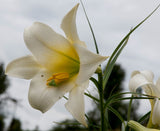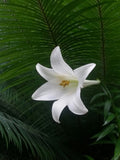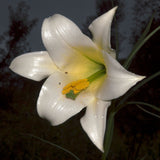Lilium wallichianum Seeds – “Himalayan Moon‑Trumpets”
Bring a slice of mist-clad Himalayas into your garden—a floral sensation that blooms like moonlit chalices in the twilight. Lilium wallichianum, the Wallich’s Lily, carries stories of ancient botanists and mountain meadows. These seeds are an invitation to cultivate a lineage of elegance, fragrance, and lofty wilderness.
1. Alpine Roots & Cultural Resonance
Named for Dr. Nathaniel Wallich, a pioneering 19th‑century explorer of Himalayan flora, this lily is a rare sentinel of the subcontinent’s high slopes and woodlands. Emerging from narrow, stoloniferous bulbs, it faithfully recreates the mystic grasslands and forest margins of India, Nepal, Bhutan, and Myanmar.
2. Bloom Beauty & Fragrant Allure
When summer wanes, slender, purple-tinged green stems — sometimes reaching up to 6 feet tall — bear horizontally held, trumpet-shaped flowers in shades of creamy white or pale yellow (“moon‑bright chalices”) often with a soft green or yellow wash. These blossoms are remarkably fragrant, with evening air carrying their scent for yards—a nocturnal invitation to slow deep breath and indulgence.
3. Growing Conditions & Hardiness
This lily prefers moist, slightly acidic soil with impeccable drainage, thriving under light dappled shade akin to its forest-edge origins. The best planting windows are spring and fall, though it's notoriously fickle—requiring patience from its gardener.
USDA Hardiness Zones vary across sources, but tend to span Zones 5–8—a testament to its surprising cold tolerance when sheltered. Some growers note success into Zone 9b, placing it among the more resilient true lilies.
4. Pollinators & Wildlife Connections
These moon-trumpets are alluring beacons for bees, drawing nocturnal and twilight pollinators with their scent and form—especially as one of the late-season blooms available. Though not known as a larval host for butterflies or moths, their blossoms provide essential nectar and pollen when few other resources remain, gifting your garden’s night-fliers and evening insects a final banquet before autumn hush.
5. Intriguing Tidbits & Botanical Legacy
-
Late-Season Stunners: Blooming in late summer to early fall—sometimes October or November—these lilies serve as seasonal encore performers when most perennials have faded.
-
Stoloniferous Spread: Their bulbs send out offsets—tiny echoes of themselves—allowing colonies to emerge and migrate gently over time.
-
Botanical Drama: Slender stems may bend under the weight of these majestic blooms—each flower is substantial, like a softly ringing bell suspended in air.
-
Edible Heritage: In some regions, the bulbs have been cooked—boiled or roasted—as a starchy vegetable, echoing culinary traditions where edible roots connect humans to local plant wisdom.
Product Summary — “Himalayan Moon‑Trumpets” Seeds
| Feature | Exceptional Details |
|---|---|
| Bloom Color | Creamy-white to pale yellow, sometimes with green shading—elegant moonlit trumpets |
| Fragrance | Yes—intensely scented, especially in still evening air |
| Hardiness Zones | USDA Zones 5–8, with some reports into Zone 9b |
| Growth Habit | Up to 6 ft tall, slender stems, stoloniferous bulbs |
| Wildlife Value | Attracts bees; late-season nectar source for pollinators |
| Season | Blooms in late summer to early fall; one of the last in the garden |
| Unique Traits | Named for a Himalayan plant hunter; fragrant, rare, dramatic, historically used as food |
Garden Magic & Cultivation Tips
-
Planting Rhythm: Sow in spring or fall into shaded beds rich in organic matter. Provide mulch that keeps roots cool but avoid excess moisture near bulbs.
-
Support the Drama: These statuesque stems may bow; consider discreet staking or planting among sturdy companions.
-
Celebrate the Night: Position them near pathways, patios, or evening seating—let their fragrance be the evening’s secret guest.
-
Patience Rewarded: Cultivation is a slow romance—treat failures as lessons, not setbacks; eventual blooms are deeply gratifying.
Bring your garden alive with Lilium wallichianum—a melody of moonlight, mountains, and timeless botanical grace.
Let me know if you’d like tips on containers, companion plants, or bloom-timing strategies—I’d love to help your garden dream unfold.










